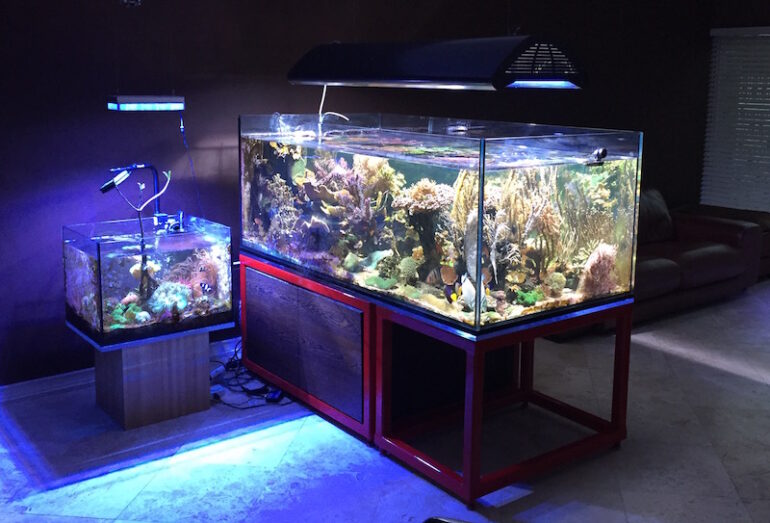One of the notions that most of us are familiar with is the “man cave”. This room of the house is usually dedicated to our enjoyment of sports, large television screens and adult beverages.
In the best of circumstances, it is where we go off to when we need solitude or when our significant other doesn’t want to watch 12 consecutive hours of some sporting event or a Game of Thrones marathon. Some of us are not lucky to have a room like this, but in its stead we have a “fish room”.
This room can also be our place of solitude or relaxation in the best of circumstances or where we constantly tinker and hide our third biggest investment and its related equipment. If you do have a fish room I am only partially joking about it being your third biggest investment after your house and car, but when done right it can bring you as much enjoyment as either of those. And unlike a car it is not a depreciating asset, but like a house it can be a money pit.

So what exactly is a “fish room”? It can be anything from a closet, basement space or cubby hole adjacent to the tank where you hide equipment. Or in the best of circumstances it can be where you house your tanks, their equipment and where you can relax and enjoy them.
I have been lucky in that I have had a fish room in each of the houses I have owned as well as in the first apartment I rented. Because of this I think I am well-positioned to discuss the do’s and don’t of setting up a fish room. Before even considering a fish room understand that relationships are all about compromise and trade-offs.
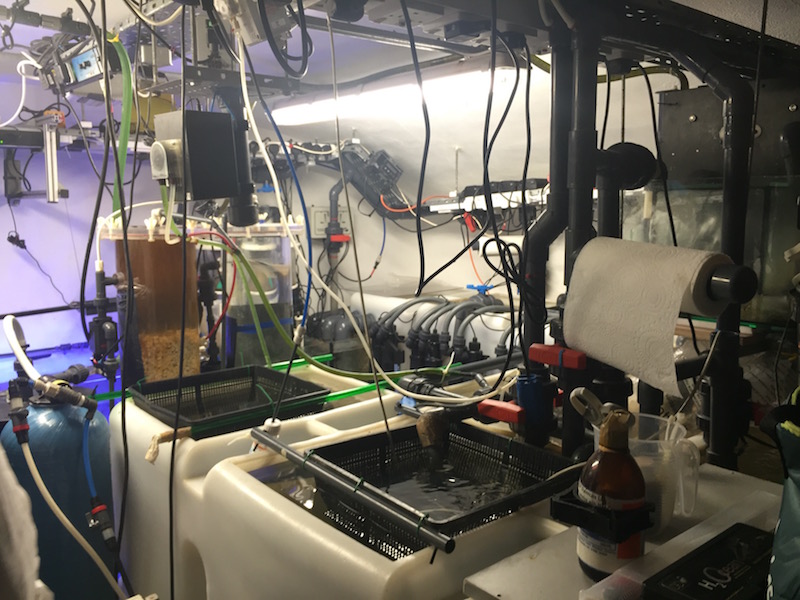
So if you think you can just say honey I’m going to commandeer the entire basement for my tanks and be on your merry way, usually you will be wrong. Getting a fish room of my very own cost me a new car for her, a new car and deck, and the construction and purchase of a large new home where I got a bay of the garage for my fish room.
Once you do have a room to call your own for fish plan what you want and where before getting started as you only have one chance to do this right. As with any project of this magnitude, take measurements, make drawings and take your time, there is no reason to rush.
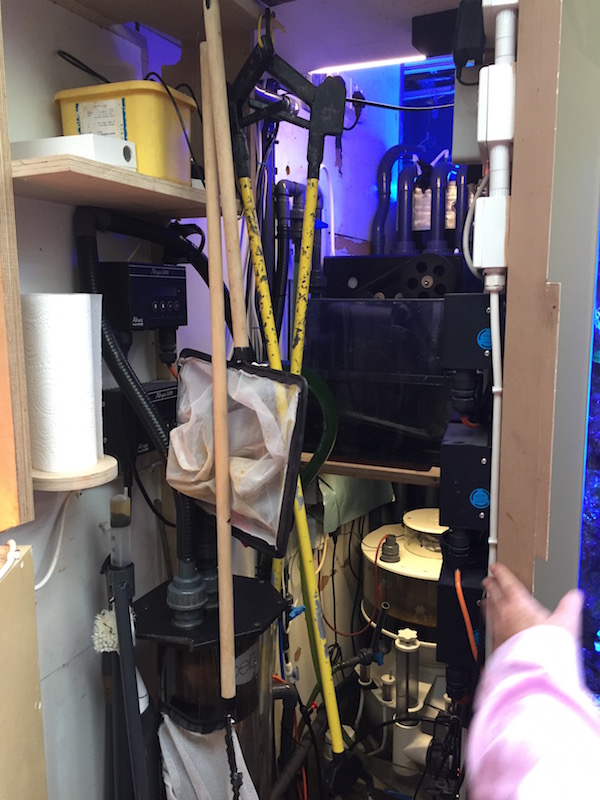
The first thing I suggest you do once you can have your room is figure out how big you want your aquarium to be. In my case when I had a basement room I had a 240-gallon tank followed by a 560-gallon tank in it. When I got the bay in the garage I was able to move up to a 1200-gallon tank. In each instance though I had easy ground level access to the room.
So if you do not have that, you made to think smaller as moving a 500 or 1000-gallon tank into a basement down stairs is not going to work. So in this instance you will need to not only think of how much space you have, but also how you are going to get the tank and it’s stand and ancillary equipment into that space. However, if you are dead set on having a huge tank in such a space you can always build it on site. Just remember that most tanks have a finite life and some day you may need to dismantle it to get it out.

If the fish room is not going to be on the ground floor or on a cement slab, then you need to consider how its weight is going to affect the structural integrity of your home. If you are going to have a tank of any size in this room, then you may need to consult an engineer to determine first if the floor can structurally support this and second what will happen to the water should a leak occur or in the worst case the tank split.
I have seen both of these occurrences occur and the result was not pretty. So I strongly advise that some sort of floor drain be installed in this room to make a leak or tank collapse not be a catastrophe for the entire house. Having a nearby floor drain in my opinion is also a good idea for any fish room as there are always spills and water, and without a drain it will go somewhere and that is usually in the worst spot possible. So having a floor drain will minimize the likelihood of a water induced problem.

Once you have determined the size tank you want to have in your fish room draw up a floor plan to scale and see how the tank fits into the space of the room. In my opinion at the very least you should be able to work on the tank from at least three sides and if the tank is especially wide or deep you should be able to work on it from all sides. But if you can only work on it from two sides the sides should be front and back.
When setting up the diagram make sure to show how you will access all of the space surrounding the tank so that the tank does not block anything. I have been in a tank room where the tank was placed in such a way that when the hood of the tank was in its proper location it blocked access to the fuse box, but it could be raised to allow access.

This may not seem like a big deal in that most of us do not go into our circuit breaker box with any regularity. But think about it, when does a circuit breaker typically trip: at the most inopportune time or in the middle of the night.
And who wants to have to raise a hood then in order to flip it back. So when doing the diagram make sure that not only the tank, but none of the related equipment obstruct anything like doors, or heater or AC vents so make sure you draw them into the diagram.
After this the next thing to look at is the electrical supply, that is how many outlets will you need, how many amps will the tank and the related equipment use and how close to the tank and the equipment will they need to be.

You do not need an outlet for every piece of equipment as you can run a lot of the low amperage pieces of equipment from power strips, but the power strips add to the amps being used and once you get above a certain threshold they will trip.
So when you are planning your room you should plan on having an electrician set up the desired number of outlets that you require as well as where you want to place them. You should also plan on having them be on their own separate lines.
Each of my fish rooms had at least two separate circuits dedicated just for them. This was done so that if any of the lines for the fish rooms tripped it would not cause a disruption in any of the other house circuits.
I learned this from my first fish room where invariably the circuit for the fish room and the outlets it was attached to would go out at the most inopportune time which usually led to a heated discussion. So to prevent this from occurring I suggest you give your fish room its own dedicated circuits.

And one last thing. As many outlets as you think you need get more. There is always some new piece of equipment coming out that needs electricity so rather than overloading another power strip get more outlets installed when you build your room.
While electricity is the life blood of a fish room because of all the equipment a fish room requires, water is also a crucial element of the fish room. And unlike electricity which only flows in one direction to the fish room, water moves in both directions.
That is a fish room will require clean fresh water to not only fill the tank(s), but also to replace water lost to evaporation, for water changes and for the quarantine tank, which no fish room should be without.
Conversely waste water and water from cleaning will need to be removed once it is used. So you will not only need a source of freshwater in your fish room, but you will also need a drain of some type.
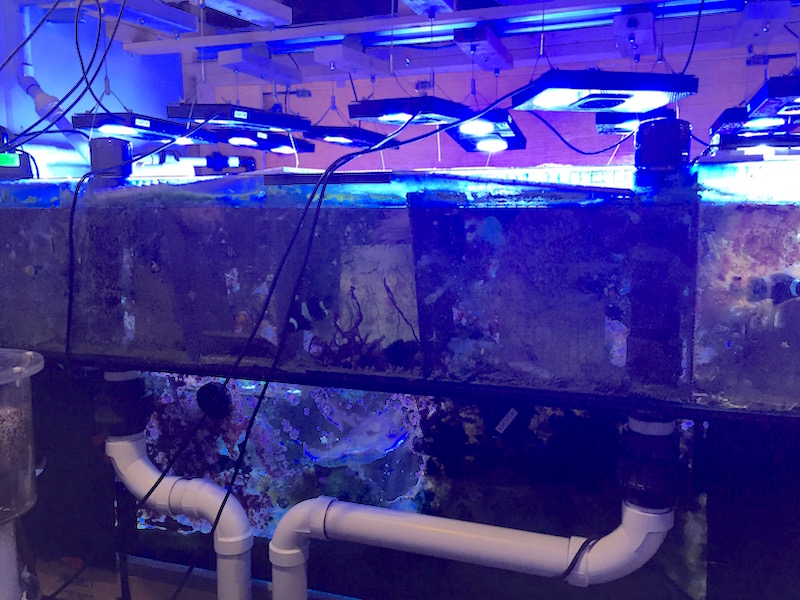
As I suggested above, a floor drain is a necessity, but I also think another drain, like on a sink, is also a good idea in a fish room as it just makes a lot of things easier to do. To me one of the worst chores in the hobby is schlepping buckets of water around the house for whatever reason.
So when you are designing your fish room all of this should be taken into account so that getting and removing water are easy to do. And if they are easy to do it is also likely that they will be done more frequently.
Having a drain to remove water is tome one of the necessities in a fish room. Another one that is often overlooked is the ned to remove the humidity that often accumulates in a fish room. When you have a tank, or even just a large sump, skimmers and the related equipment moving water, the humidity in the room can become overwhelming.

And if the humidity gets high in the fish room it can also spill over into the rest of the house. Therefore, a means of dehumidification should be included when the fish room is designed. This can be as simple as including small room dehumidifier or an exhaust fan that turns on when the humidity level reaches a certain point or a complex as adding a whole house dehumidifier to the furnace and air conditioner.
Regardless of which route you choose, you need to make sure excess humidity does not become a problem as even a relatively small tank can evaporate a fair amount of water over time. And like the tank itself you also have to make allowances for removal of this additional wastewater. So a means for draining the dehumidifier needs to be designed in to the fish room.
Once all of these things are drawn into the fish room, the next thing to take into consideration is where all of the equipment will go. If the tank is in the room, will it all fit under the tank, around the tank or where.
While a fish room is your private refuge there should still be motivation to keep it uncluttered and easy to work in. When it is designed properly it makes working on the tank easy to do and more likely that the “not fun” part of the hobby will get done.
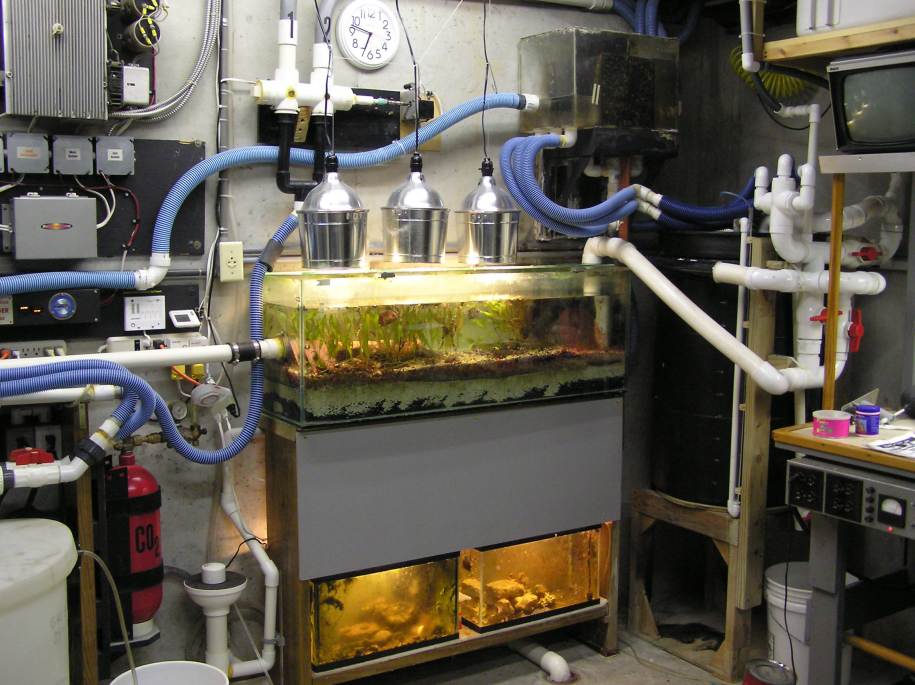
I strongly suggest that when setting up this room when the skimmers and pumps are drawn in they be where they can be easily accessed so that maintenance is easy to do and doesn’t require acrobatic skills, which was one of the shortcomings of my first fish room.
In addition to this I also suggest that some of the things that will be done regularly like water changes be designed into the room so that they can be done quickly and easily. That is if you can allow for a reservoir to hold freshwater and(or) make up water to do water changes in the long run it will make doing them much easier.
You don’t want to have to mix up buckets or worse haul in buckets every time you want to do a water change. Design the room so that doing a water change is as effortless as possible and it is more likely that you will do them with regularity and it won’t detract from your enjoyment time.

Similarly design some storage space in your fish room to hold your test kits and maintenance equipment so that it is right at your fingertips. If you have ready access to testing equipment odds are you will do it more often than if it is in a box somewhere and you have to take time to even find it.
The more often you test the quicker you get at doing it and the more reliable your results. The same is true of maintenance so have the tools you need such as glass cleaners, razor blades etc handy so that you can get to them quickly as well.
And also have places and hooks to hold towels, paper towels and things to dry up spills handy too as there will be water in your fish room so keeping it from being in places you don’t want should be designed in when you set up the room.
You want your fish room to be tidy and neat so that when your significant other sneaks a peak at it there is not any conflict about your housekeeping skills. In my own experience when my fish room was neat and uncluttered my tanks seemed to look better too. And no I was not getting baked in my fish room, it is just how it seemed to me and anyone else who I let into my room.
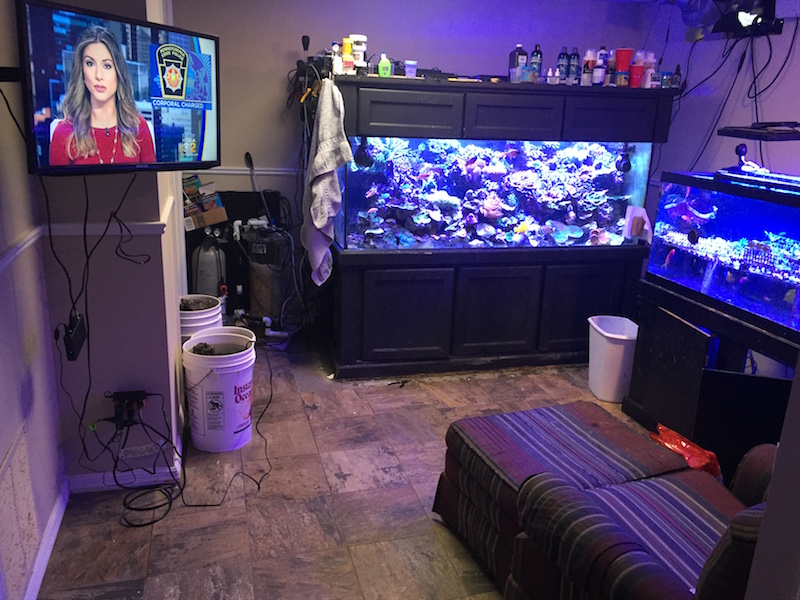
So far all I have talked about is the utility of the fish room, but when I have set up my fish I have tried to make them more than just a room to hold equipment or a tank. I try to make them be my room and I try to make them fun to be in. This is especially important as for a lot of us our fish rooms are like an oasis away from all of the everyday stress we face.
Because I have looked at mine that way I have tried to make them a room where I can totally get away from everything. My current fish room not only has my 300-gallon display tank, but it also houses my 90-gallon frag/quarantine tank and a 26 gallon nano tank. But that is not all, the room also has a tv on the wall as well as its own bathroom.
Besides those I have also put a big overstuffed chair in the room as well with a perfect vantage point for all of the tanks. And since I get Wi-Fi there as well, I can hunker down in the room and spend an entire day just relaxing and watching the tank. It is a comfortable place to hang out in, especially in the winter.

For many of us our fish rooms are our “man caves” where we can relax, work or get away from things when we work on our hobby. Many of us spend considerable time on our tanks, so is it any wonder that when we can we dedicate a room to our hobby. However, unlike a room for most hobbies, we need to customize it in order to fully to enjoy it.
But when we do it right our fish rooms can be a special room where we can get away. It is funny that as I recall when my kids were young and would come out to visit me when I was working in the fish room they would usually sit quietly and watch the tank and watch me work and ask questions when they saw me doing something that they did not understand.
So a lot of the time it was a place to escape for them as well. I am not planning on moving again, but if I did I would only move to a house where I could have another fish room. After having one for the last 30 years I could not imagine doing a tank without one.


